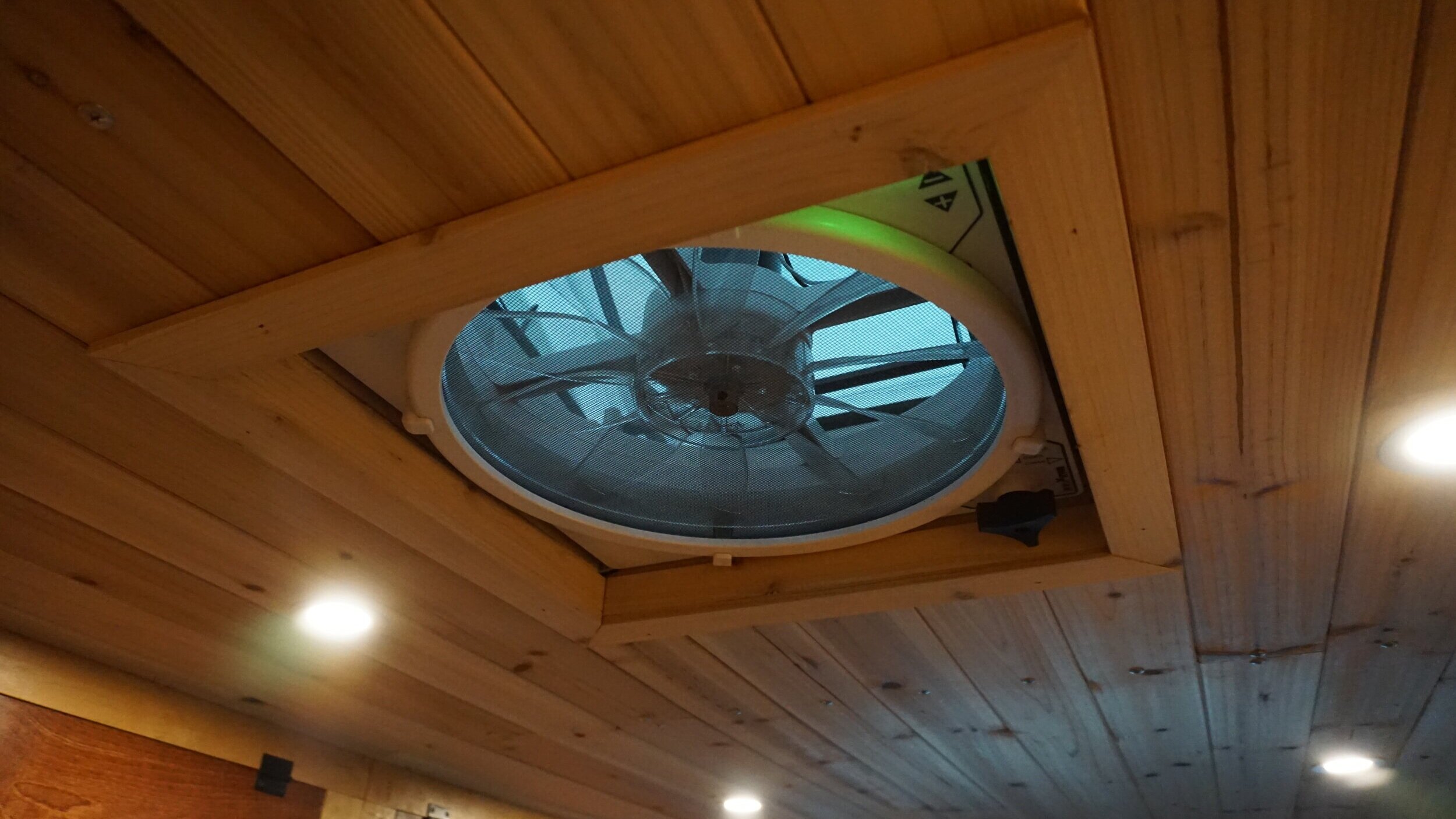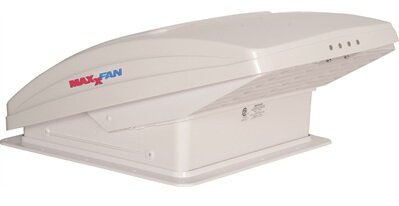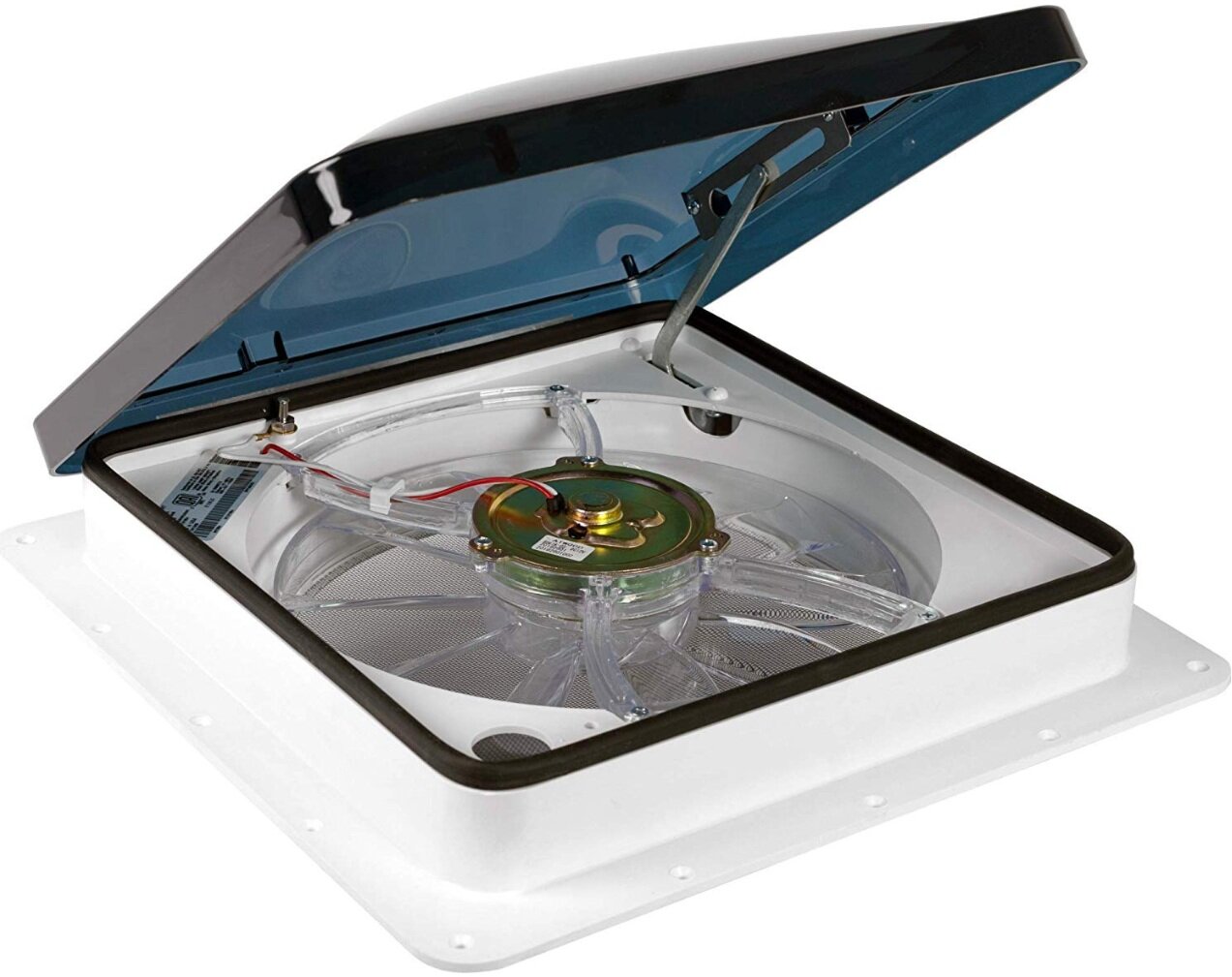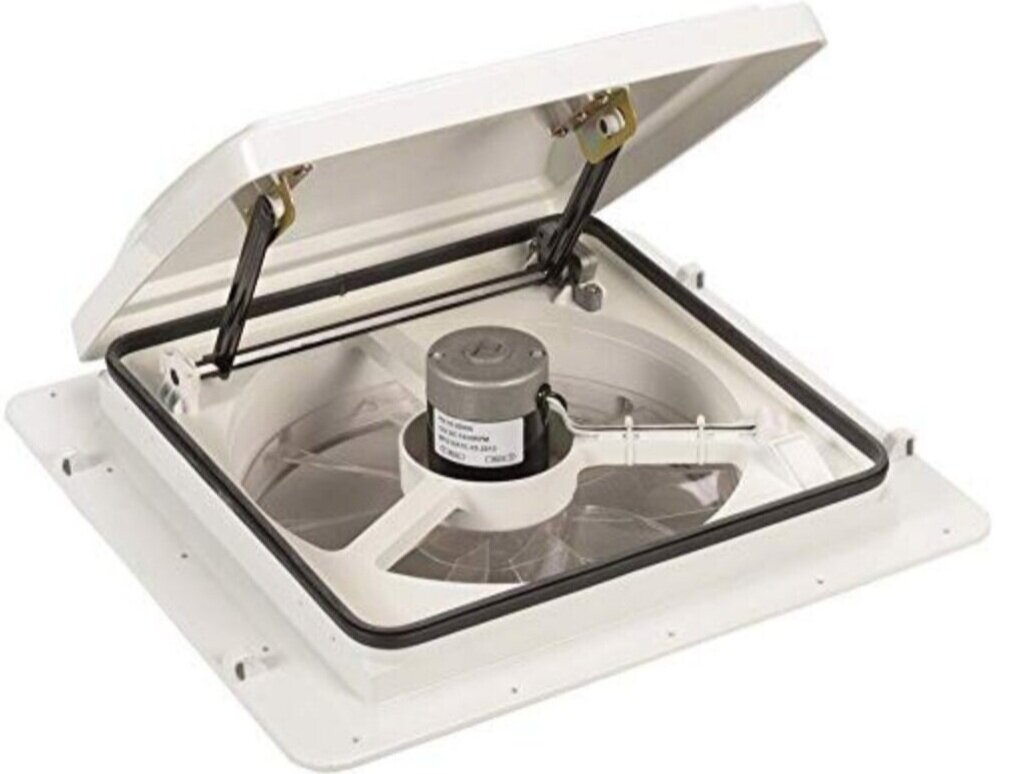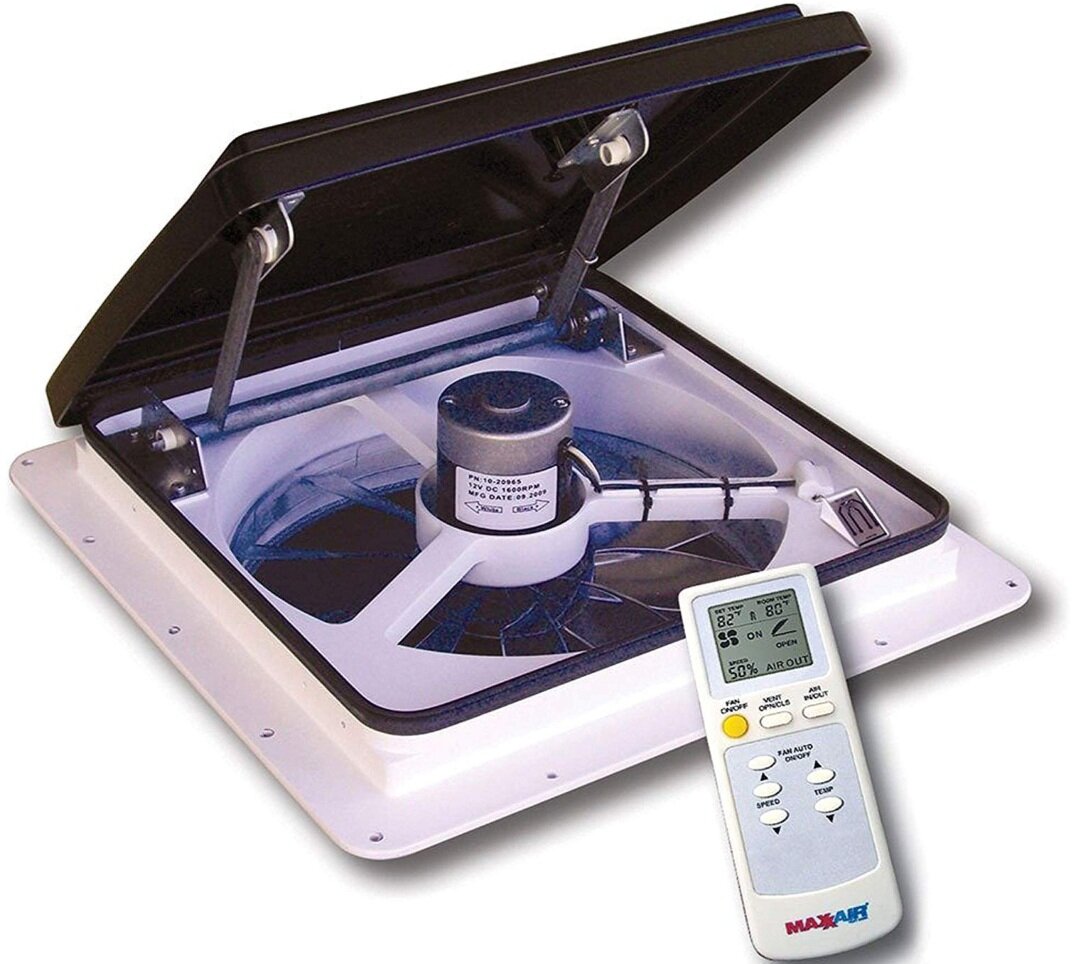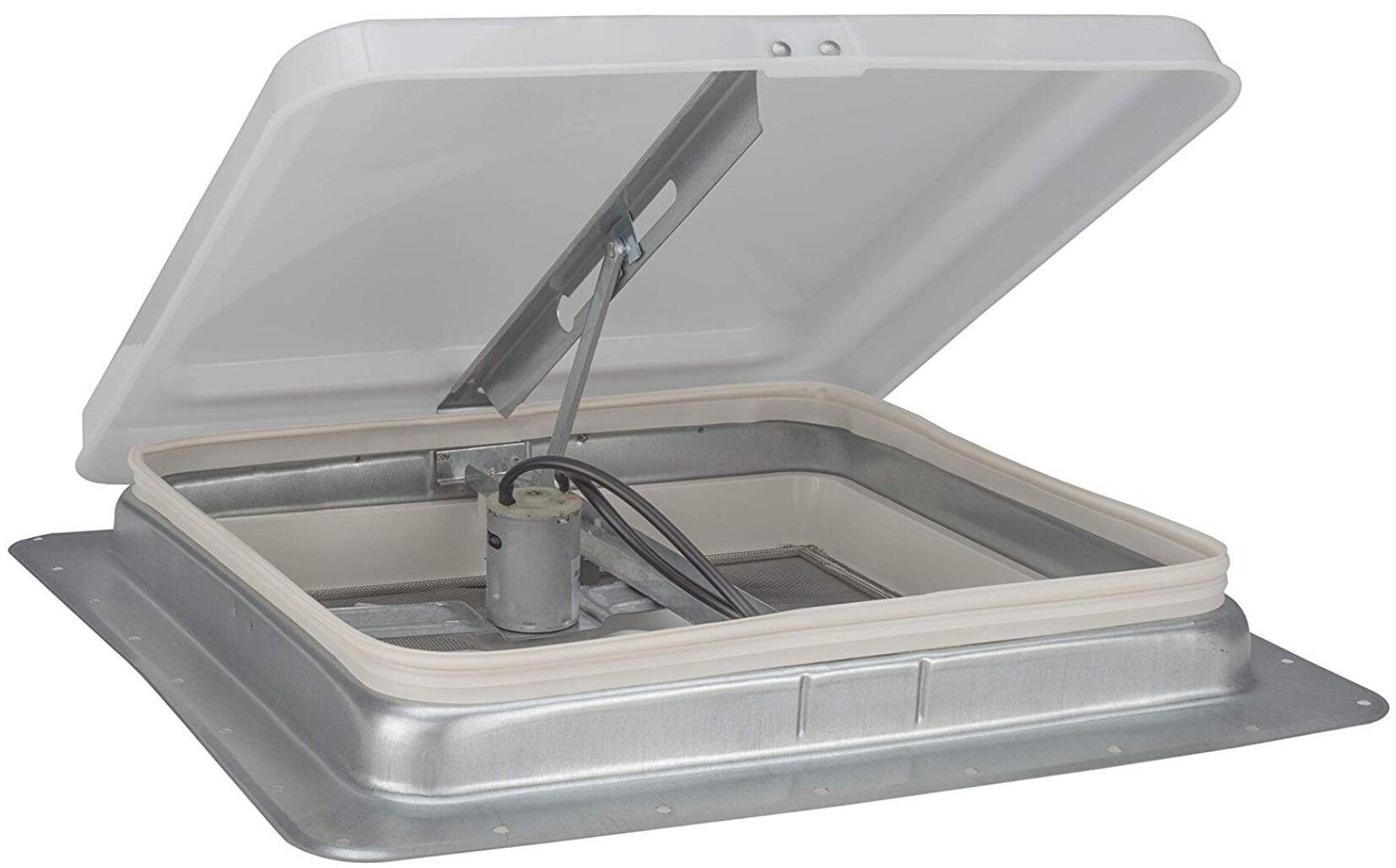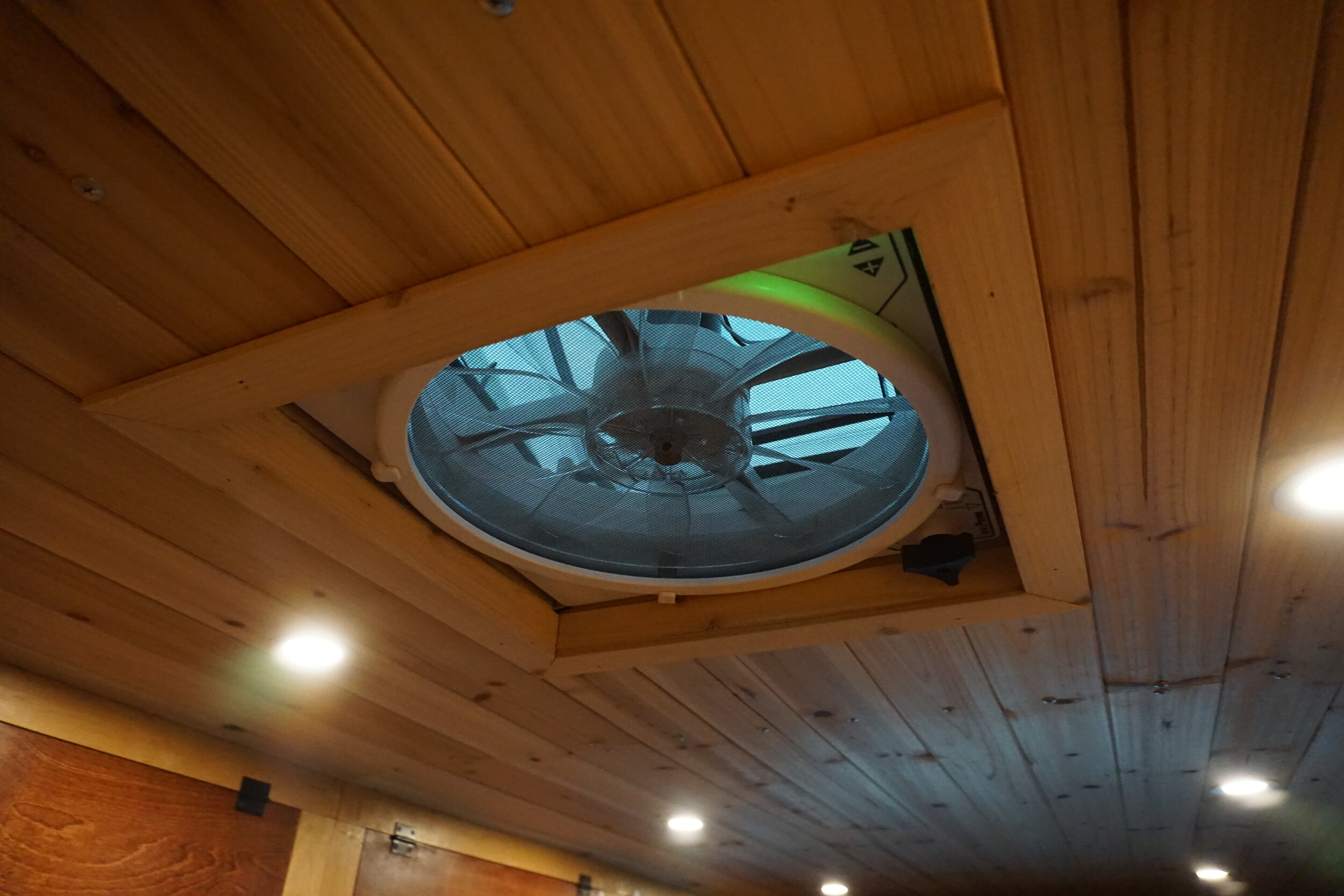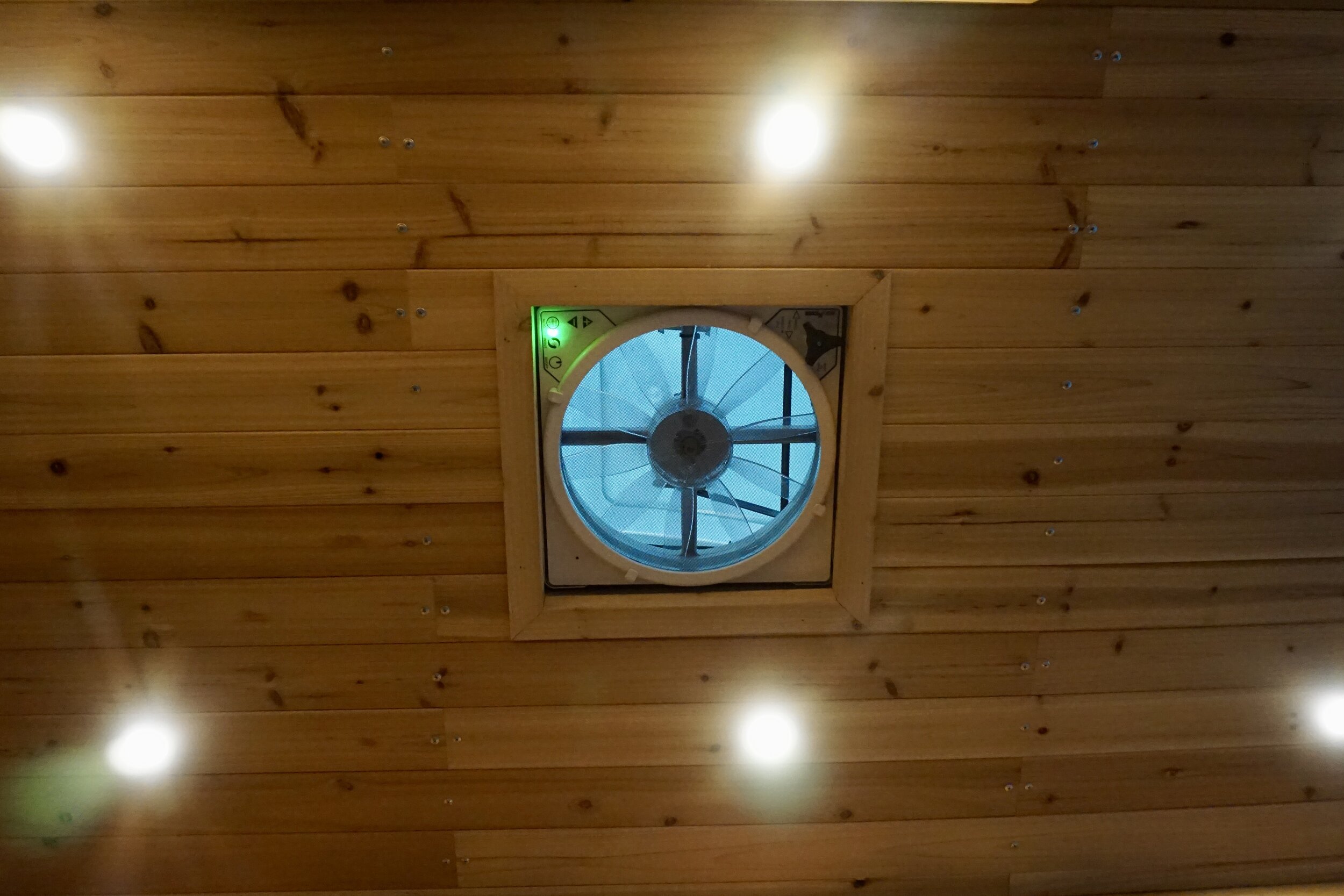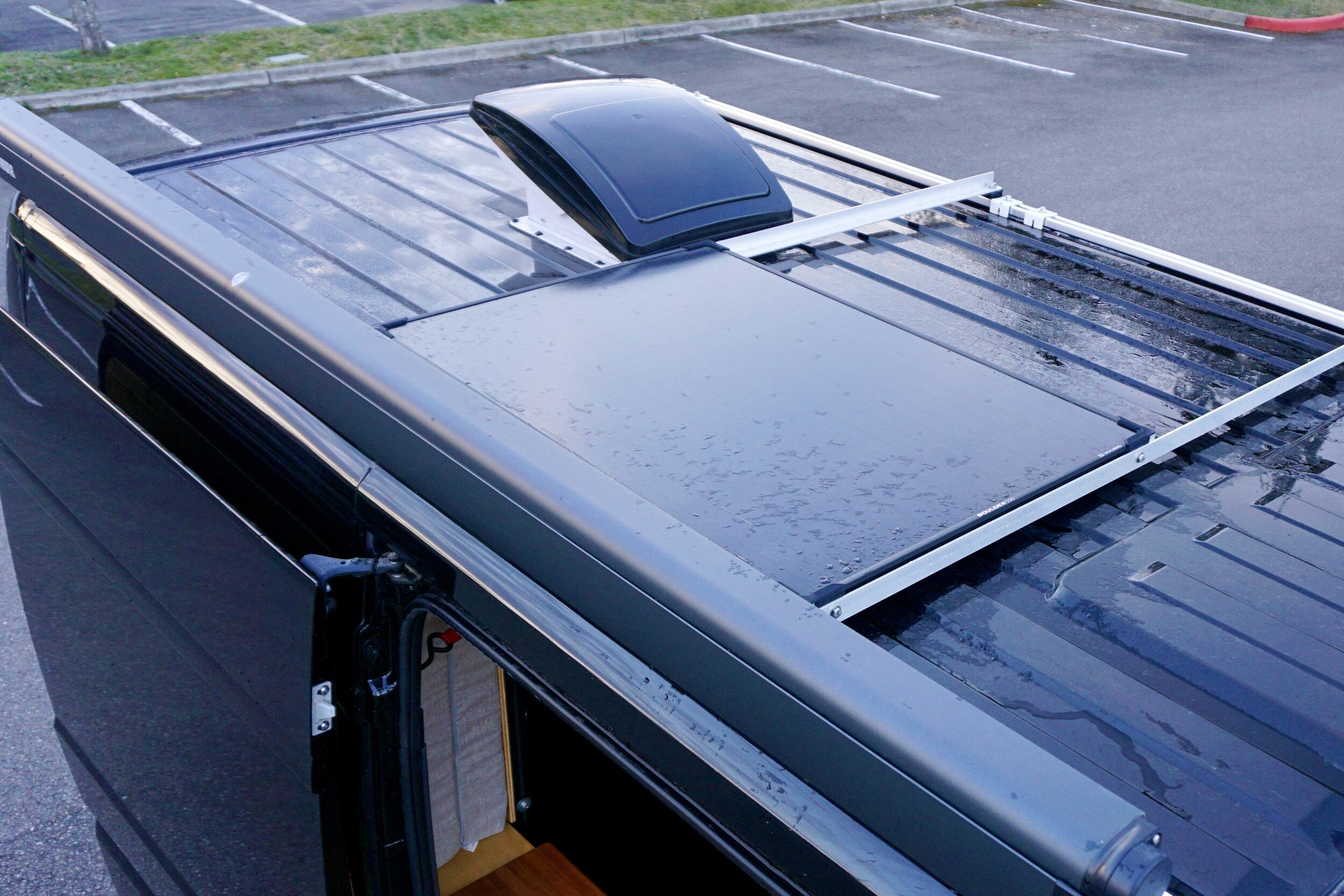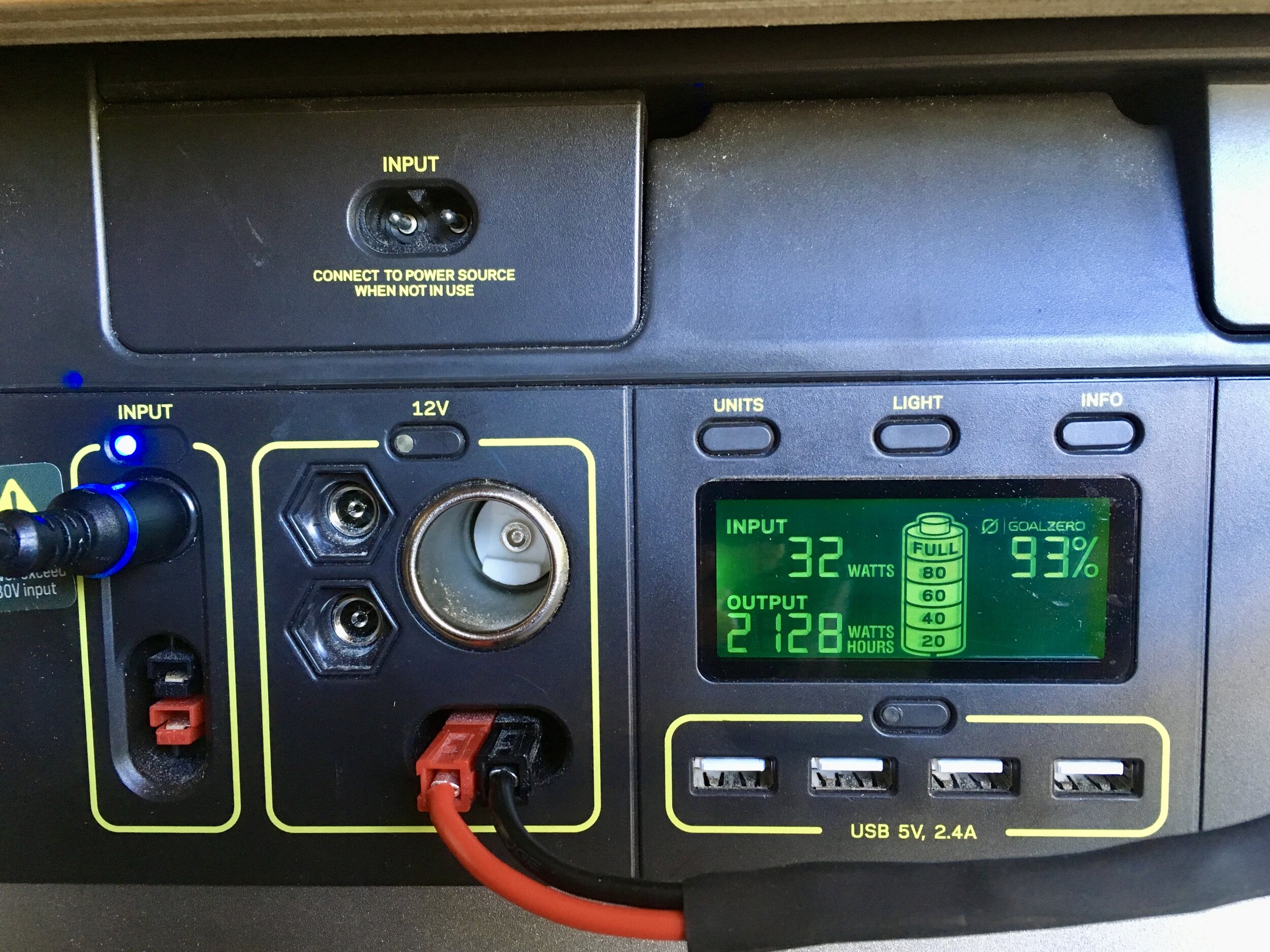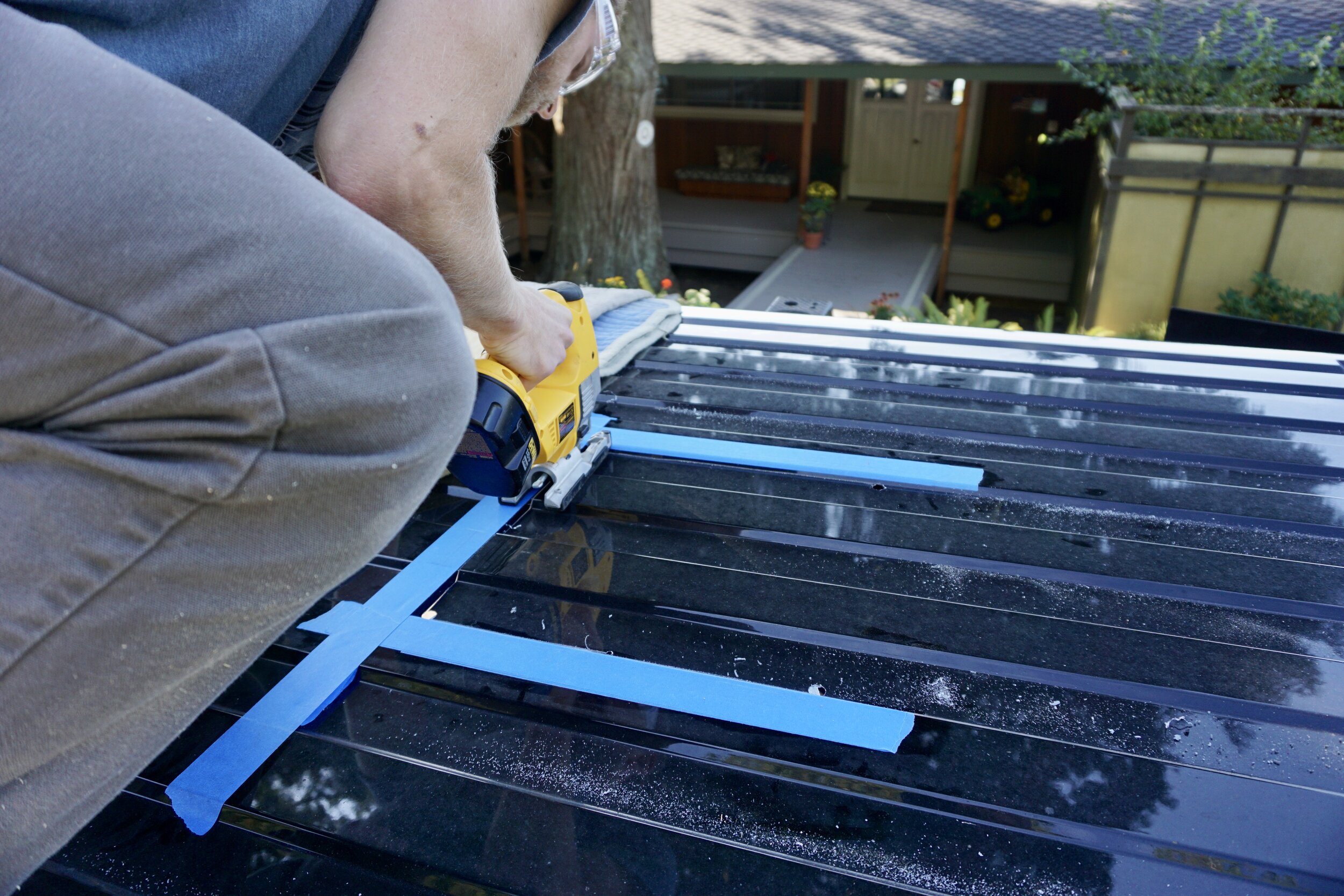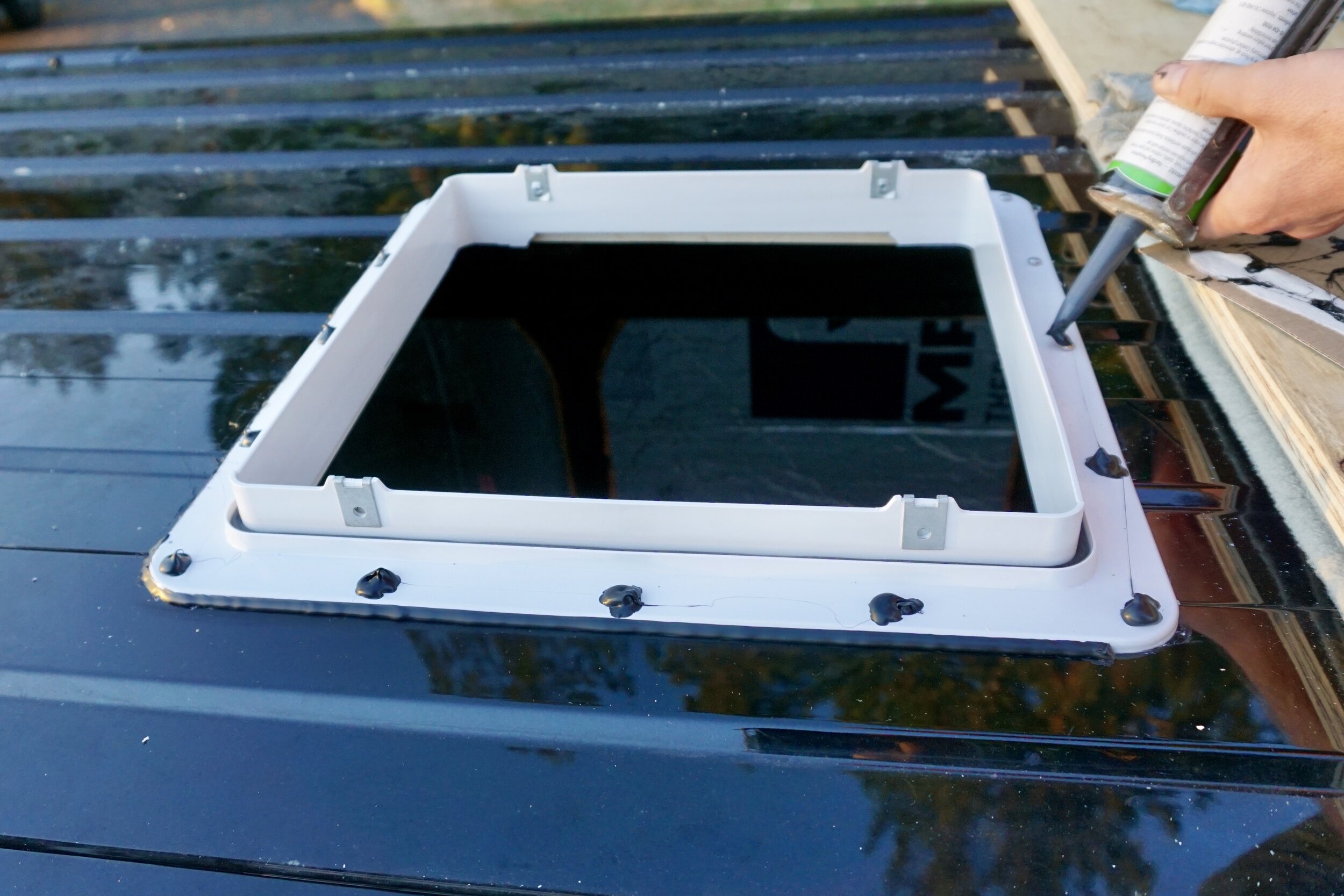BEST RV AND CAMPER VAN ROOF VENT FANS OF 2024
Updated: January 11, 2024
A quality roof vent fan is essential for camping bliss; it helps regulate the temperature inside your RV or van, is great for removing smells and smoke while cooking, and is a must-have for circulating fresh air while sleeping. After years of personal use and research, we’ve compiled our list of favorites, which range from uber-expensive remote-control models from Maxxair to simple motor-less vents from Heng’s. For detailed instructions on how to install your fan, check out our DIY installation guide here.
Best Overall Roof Vent Fan
1. Maxxair MAXXFAN Deluxe 6200K
Price: $275
Motor: 10-speeds, intake/exhaust
Controls: On fan
Thermostat: Yes
Rain Shield: Yes
Why We Like It
The Maxxair MAXXFAN Deluxe 6200K has been a long-time favorite among van campers and RVers for years. What makes the MAXXFAN Deluxe 6200K so popular is its combination of features, ease of use, and reasonable price tag. For about $250, you get a 10-speed fan that works as an exhaust or intake, a thermostat to help control temperatures inside your RV or camper van, and an easy-to-use manual lid opening. Perhaps best of all–and especially important for wet-weather users–is the smartly-designed rain cover that allows fresh air to enter even in the nastiest of downpours–something that’s not possible with the Dometic-Fan-Tastic Vento 1250 below. All said, the Maxxair MAXXFAN Deluxe 6200K is our top roof vent fan for 2024.
How It Compares
The Maxxair MAXXFAN 6200K should more than satisfy the needs of most campers, but if money is no object and convenience is high on your must-have list, then the Maxxair MAXXFAN Deluxe 7500K is the perfect alternative. For an additional $50, you get all the functionality of the MAXXFAN 5100K but with the added benefit of remote-control operation and an electric lift–making it ideal for hard-to-reach locations or adjustments from bed. A less expensive, yet well regarded, alternative is the Dometic Fan-Tastic Vent 1250 listed below. Compared to the MAXXFAN Deluxe 6200K, the Fan-Tastic Vent 1250 only has three speeds and can’t be used in the rain, but it’s a great match for dry-weather campers and costs about $50 less.
Best Roof Vent Fan (for $75 less)
2. Dometic Fan-Tastic Vent 1250
Price: $200
Motor: 3-speeds, intake/exhaust
Controls: On fan
Thermostat: No
Rain Shield: No (rain sensor)
Why We Like It
Striking the perfect balance between features and price, the $200 Dometic Fan-Tastic Vent 1250 fan is a great alternative to the more expensive Maxxair MAXXFAN Deluxe 6200K above. The strong three-speed fan and 10-inch blade do a great job of circulating air inside your RV or camper van and the reversible motor gives you the flexibility to pull air in or out based on your needs. Additionally, the low profile and streamline design is great for stealth campers and is out top choice for such purposes. If you’re looking for a simple fan that includes everything you need and nothing you don’t, it’s hard to beat the Fan-Tastic Vent 1250 from Dometic.
How It Compares
The Dometic Fan-Tastic Vent 1250 is a great option for those looking to stay around $200, but you do miss out on the premium features found on more expensive models. For starters, the small vent cover doesn’t protect the fan from moisture while in use, which is a major downside for foul weather users. Second, the three-speed motor (the Maxxair MAXXFAN Deluxe 6200K above has 10) offers fewer adjustments to dial in the perfect amount of airflow. And finally, the single arm that supports the cover has a tendency to flutter while driving and isn’t as secure as two-armed models. All said, we think it’s worth spending up for the Maxxair MAXXFAN Deluxe 6200K above, but if you’re looking to save a few bucks then the Dometic Fan-Tastic 1250 makes a lot of sense.
Best Budget Roof Vent Fan
3. Maxxair MAXXFAN 4401K
Price: $135
Motor: 4-speeds, exhaust
Controls: On fan
Thermostat: No
Rain Shield: No
What We Like
We almost feel bad for including so many Maxxair branded roof vent fans on our list, but the fact of the matter is they have a ton of great options. Take their MAXXFAN 4401K for instance; for barely more than a Benjamin Franklin (the fan is $135 to be exact) you get a powerful 4-speed motor that offers plenty of power for circulating air inside your RV or camper van. That’s one heck of a deal. Don’t expect to find a boatload of features on the MAXXFAN 4401K–those are reserved for models costing two or three times as much–but the mighty Maxxair MAXXFAN 4401K is the perfect companion for budget-oriented DIY camper van conversions or low-cost RV replacements.
How Does It Compare
Alluded to above, if features and options are what you seek, then the Maxxair MAXXFAN 4401K probably isn’t for you. You won’t find a rain shield or sensor–which means wet-weather campers should look elsewhere–and the fan doesn’t have a thermostat for automated temperature regulation. Additionally, the MAXXFAN 4401K only runs in one direction, and you certainly won’t find a remote control for in-bed operation. For a slight increase in cost but a big bump up in features, we recommend the Domestic Fan-Tastic 1250 above. But for those who are on tighter budget, the $135 Maxxair MAXXFAN 4401K is a smart choice.
Best Remote Control Roof Vent Fan
4. Maxxair MAXXFAN 7500K
Price: $300
Motor: 10-speeds, intake/exhaust
Controls: On fan and remote
Thermostat: Yes
Rain Shield: Yes
What We Like
The Maxxair MAXXFAN Deluxe 7500K shares a lot in common with our top pick, the MAXXFAN Deluxe 5100K. Both models use the same 10-speed fan that works as an intake or exhaust, are able to operate when it’s raining outside, and include a thermostat for automatic temperature regulation. However, the MAXXFAN Deluxe 7500K has a leg up on the MAXXFAN 5100K in important two areas. Most noteworthy, the Maxxair MAXXFAN Deluxe 7500K includes a remote control that allows users to operate the fan from the convenience of their bed or while driving. The remote is also perfect for hard to reach locations. Secondly, the MAXXFAN Deluxe 7500K’s lid opens electronically, which is far more convenient to operate than the manual version found on the MAXXFAN Deluxe 5100K. The $300 price tag may be hard for some to swallow, but if price is no object then the Maxxair MAXXFAN Deluxe 7500K is the easy choice.
How It Compares
Mentioned above, the biggest downside of the Maxxair MAXXFAN Deluxe 7500K is the $300 price tag. The remote control and electric lift are certainly nice options for some users, but the added costs and complexity is likely overkill for most. For those of you who agree, we wholeheartedly recommend our top pick above, the Maxxair MAXXFAN Deluxe 6200K. The slightly downgraded roof vent fan may not include all the fancy features of it’s more expensive brother, but the 10-speed motor and functionality is identical in all other ways. For about $90 less, we think the MAXXFAN Deluxe 5100K is the smarter choice.
Our Top Four Roof Vent Fans Compared
| Roof Vent Fan | Price | Motor | Controls | Thermostat | Rain Shield |
|---|---|---|---|---|---|
| 1. Maxxair MAXXFANN 6200K | $275 | 10-speeds, intake & exhuast | On fan | Yes | Yes |
| 2. Dometic Fan-Tastic Vent 1250 | $200 | 3-speeds, intake & exhuast | On fan | Yes | No |
| 3. Maxxair MAXXFAN 4401K | $135 | 4-speeds, intake | On fan | No | No |
| 4. Maxxair MAXXFAN 7500K | $340 | 10-speeds, intake & exhaust | Remote & On fan | Yes | Yes |
Top Rated Alternatives
5. RVLOVENT
Price: $130
Motor: 3-speeds, intake
Controls: On fan
Thermostat: No
Rain Shield: No
What We Like
If you’re looking for a highly functional RV or camper van roof vent fan that doesn’t break the bank, then the RVLOVENT is a solid place to start. For around $130, you get a powerful 3-speed motor with 10 fan blades that’s capable of putting out 950 CFM (cubic feet per minute)–which is on par with the more premium models listed above. We can’t say there’s anything particularly spectacular about the RVLOVENT–we are talking about roof vent fans after all–but it’s a reliable model that’s continues to prove itself year after year.
How Does it Compare
Sometimes all you need is a simple fan to circulate air in your van or RV, and for you, the RVLOVENT makes a lot of sense. Having said that, for shoppers looking to get the most bang for their buck, we think our top budget pick above is the better choice. Compared to the Dometic, the Maxxair MAXXFAN 4401K above has the same basic one-way fan but features an additional speed (for a total of four) and comes in about $20 less. In the end, we don’t see a good reason to go with the RVLOVENT over the Maxxair MAXXFAN 4401K.
6. Maxxair MAXXFAN 4500K
Price: $245
Airflow: 10-speeds, intake/exhaust
Controls: On fan and remote control
Thermostat: Yes
Rain Shield: No (rain sensor)
What We Like
Maxxair has one of the most comprehensive roof vent fan lineups on the market, and the MAXXFAN Plus 4500K lands right about in the middle in terms of price. For about $245 you get a powerful 10-speed motor for moving air, a built-in thermostat for regulating internal temperature, and a sensor that closes the lid once it detects rain. Most noteworthy, however, is that it’s one of the least expensive RV and camper van roof vent fans to include a remote control–which is great for hard to reach locations or using while in bed. All said, if saving money and increasing convenience are at the top of your must-have fan list, then you can stop your search with the Maxxair MAXXFAN Plus 4500K.
How Does it Compare
There’s no question that the MAXXFAN Plus 4500K is the best budget-oriented remote-control roof vent fan on the market. However, compared to the more expensive MAXXFAN Deluxe 7500K above, it falls short in wet-weather performance. The oversize lid of the MAXXFAN Deluxe 7500K model allows users to run the fan even when it’s pouring rain outside, something that’s simply not possible with the MAXXFAN Plus 4500K. For those who recreate in dry climates, the less expensive MAXXFAN Plus 4500k is the easy choice, but for those who camp in all sorts of conditions, we recommend going with the Maxxair MAXXFAN Deluxe 7500K listed above.
7. Heng’s 71112-C
Price: $55
Airflow: Intake
Controls: On fan
Thermostat: No
Rain Shield: No
What We Like
At the complete budget end of the spectrum, the Heng’s 71112-C offers an acceptable amount of air flow for smaller vehicles. Priced at an ultra-affordable $55, the Heng’s 71112-C features a one-speed motor that powers a small 6-inch blade–which is just enough to keep the air flowing in tight spaces. We certainly wouldn’t choose it as our primary roof vent fan, but it is a great choice for smaller applications or as a second venting options in larger RVs or camper vans.
How Does it Compare
It’s important to have realistic expectations for a fan that costs the same as a weeks' worth of lattes–the Heng’s71112-C is about as basic as they come. Compared to our top budget pick, the $135 Maxxair MAXXFAN 4401K, the Heng’s is pretty bare bones. For another $80 you get three additional fan speeds for more control and the 12-inch blades produce significantly more draft. Further, the Maxxair MAXXFAN 4401K can be used as a ceiling fan when it’s closed. We think it’s worth spending up for the added features, but the Heng’s 71112-C makes a nice true budget option or as a second fan.
8. Heng's 71111-C1G1
Price: $45
Motor: No
Controls: No
Thermostat: No
Rain Shield: No
What We Like
Not necessarily a fan–but a similarly effective product nonetheless–a basic vent is a great way to boost circulation and improve airflow in your camper van or RV. As a standalone unit, simple vents aren’t very impressive, but when paired with a fan, they can significantly increase air movement inside your camper. For such purposes, we think the Heng’s 71111-C1G1 is a solid choice. It isn’t the fanciest design, but the manual lift and large opening do a great job of letting air in, and the mesh screen keeps unwanted bugs and debris at bay. For boosting airflow on a budget, motorless vents make a lot of sense.
Roof Vent Fan Comparison Table
| Roof Vent Fan | Price | Motor | Controls | Thermostat | Rain Shield |
|---|---|---|---|---|---|
| Maxxair MAXXFANN Deluxe 6200K | $275 | 10-speeds, intake & exhuast | On fan | Yes | Yes |
| Dometic Fan-Tastic Vent 1250 | $200 | 3-speeds, intake & exhuast | On fan | Yes | No |
| Maxxair MAXXFAN 4401K | $135 | 4-speeds, intake | On fan | No | No |
| Maxxair MAXXFAN Deluxe 7500K | $340 | 10-speed, intake & exhuast | Remote & on fan | Yes | Yes |
| RVLOVENT | $130 | 3-speed, intake | On fan | No | No |
| Maxxair MAXXFAN Plus 4500K | $205 | 10-speed, intake & exhuast | Remote & on fan | Yes | No |
| Heng's 71112-C | $55 | 1-speed, intake | On fan | No | No |
| Heng's 7111-C1G1 | $45 | No | No | No | No |
Roof Vent Fan Buying Information
Do I Need a Roof Vent Fan?
RV and camper van roof vent fans may seem unnecessary to some, but experienced travelers know the important role they play while living on the road. First off, a quality roof vent fan is the best way to bring fresh air into your vehicle. Cracking a window or leaving the door open can have a similar effect, but the draft provided by a powered fan simply can’t be matched in passive ventilation techniques. Second, if you plan to cook inside your van or RV–which inevitably will happen–then being able to vent steam, smoke, and odors is critical. And while roof vent vans will never be able to match a dedicated air conditioning unit, they’re a great way to regulate temperatures once it cools off outside. Finally, managing moisture buildup in damp environments is much easier with a roof vent fan for your RV or DIY camper van.
The Maxxair MAXXFAN Deluxe 6200K strikes a nice balance between features and price
Airflow and Direction
It would be safe to assume that all fans are created equal in terms of moving air, but the fact of the matter is that there is quite a bit of variation between models. Budget options–like the Maxxair MAXXFAN 4401–feature a basic design which is comprised of a one-way motor that is restricted to pulling air out of your camper. Although this is likely sufficient for most people’s needs, if you’re willing to spend a little more, you can get a fan with blades can go in either direction. The Maxxair MAXXFAN Deluxe 6200K’s motor, for example, is able to turn in either direction which allows users to suck air in as well as pull air out of your camper van or RV. We love being able to suck steam and smoke out of our van while cooking, but reversing the direction is great for moving air inside while sleeping.
Beyond the direction of the airflow, it’s important to understand how much air a fan is able to move. Measured in cubic feet per minute–which is commonly referenced as CFM–most high-quality fans are rated around 900. We won’t get into the technical details too much, but finding a model that’s rated for similar output is something you want to keep an eye on.
Controlling Your Fan
If all-out convenience is high on your priority list, then it’s hard to go wrong with a remote-controlled fan. Not only are you able to make changes and adjustments from the comfort of your bed, but they’re great for hard to reach locations or for those who are vertically challenged (ourselves included). We particularly like the Maxxair MAXXFAN Deluxe 7500K for such a purpose. With the battery-operated remote, you can easily make adjustments to fan speed, open and lower the vent, and turn the motor on and off. It may seem like overkill for some, but the added convenience is worth it to many.
The on-fan controls of the Maxxair MAXXFAN Deluxe 6200K are easy to use
At the other end of the spectrum you have a basic model like the RVLOVENT, whose fan is controlled by a simple knob located on the underside of the unit. The three-speed motor–which only operates in one direction–features a simple “0, 1, 2, 3” and controls both the power and speed of the blades. If you’re looking for simple, effective, and inexpensive, the Dometic is a great choice.
Thermostat
While not one hundred percent vital, roof vent fan thermostats are a nice way to help regulate temperatures inside your camper van or RV. Many models, like the Maxxair MAXXFAN Deluxe 6200K, have an adjustable thermostat that automatically controls the fan’s speed. Once the internal temperature reaches a certain point, the fan kicks on to bring fresh air into the van. While simple roof vent fans will never be able to compete with a dedicated AC unit, the thermostat function that’s found on certain models can be an invaluable tool.
Rain Shield and Dome
Simple in nature but essential in practice, roof vent rain shields are indispensable for your DIY camper van conversion or RV replacement fan. In short, a properly designed fan should allow users to use their fan and circulate air even when it’s dumping rain. Some models, like the Dometic Fan-Tastic Vent 1250, have a built-in rain sensor that closes the fan once it detects moisture and is great for keeping your interior dry. However, for a step up in performance, we prefer the larger design that the Maxxfan MAXXAIR Deluxe series employs. While the full coverage rain shield of the Maxxfan does take up a little more roof real estate–which could theoretically interfere with solar panels or a rack–we think it’s a worthwhile trade-off for wet-weather performance. Perhaps it’s our Pacific Northwest location, but we put a high premium on being able to vent air even while mother nature is having her way.
It’s important to think about other roof-mounted accessories when deciding the location of your fan
Another consideration regarding the top of your fan is the dome. On budget-oriented models, like the Maxxair MAXXFAN 4401K, you’ll find a solid piece of white plastic that lets little or no light through. Another option is the transparent domes that are found on the likes of the Dometic Fan-Tastic Vent 1250. These styles are great for letting a little more light into your camper van or RV, however, some users prefer the solid plastic types for keeping light out. At the end of the day, there’s no right or wrong answer; it simply comes down to which style you prefer most.
Power and Energy Draw
An important part of any DIY camper van conversion is figuring out how much energy each component in your build will use. Luckily, roof vent fans consume very little power when compared to other appliances, especially when used on their lower setting. Take the Maxxair MAXXFAN Deluxe 6200K for example, which uses about 0.2 amps on low (speed 1), 1 amp on medium (speed 5), and 4.5 amps on high (speed 10). We won’t get into the details here, but if you had an 80-amp hour battery that is fully charged, that’s anywhere from about 18 hours to two weeks of runtime.
The Goal Zero Yeti 1000 Lithium makes a great all-in-one power source
Fan Size
Most standard roof top fans come in three sizes: 14 ¼ inches by 14 ¼ inches, 14 x 14 inches, or 13 x 14 inches wide. If you’re replacing an old fan, or simply looking for an upgrade, it’s especially important to pay attention to these dimensions. However, for everyone else installing one for the first time, just being aware is generally good enough. Having said all that, the majority of the most popular Maxxfan and Dometic models on the market require a 14 inch by 14 inch opening for installation.
Location and Installation
We won’t get too granular here, but installing a roof vent fan is one of the first steps of a DIY camper van conversion and is a fairly straightforward process. Before getting started, we like to consider the location of the fan–both to maximize the effectiveness and to ensure it doesn’t interfere with the rest of the build. If you plan to crack your front windows–in addition to using the fan–for airflow, we think it’s a good idea to place the fan near the back of the vehicle. This allows the air to travel the entire interior length of the camper van and provides the most bang for your buck. And to our second point, you don’t want your roof vent fan to interfere with future or current roof top accessories like a solar panel or rack.
Adding tape to the surface of your roof saves it from scratches and future rust
After the location has been decided upon, it’s time to get to work. Start by making a cardboard template of the fan opening, this takes any guesswork out of the equation. Once positioned correctly and in line with the van, make a mark at each corner of the template with a sharpie. Follow this by drilling a small hole at each point, making sure it’s large enough for a saw blade to fit inside of. Next up, use your electric jigsaw to cut from one corner to the next–we found it helpful to think about cutting one straight line at a time, as it’s considerably less intimidating than an entire square.
Applying lap sealant to the outside of your fan ensures you won’t get leaks
Once the hole has been cut out and the edges have been filed down, you’re ready to prep the area for weatherproofing. To ensure zero leakage, we recommend a combination of butyl tape between the fan frame and the van, and then a bead of lap sealant around the perimeter and on top of the screw heads. Screw your fan into the van and you're done (minus the wiring of course). One final note we think is worth mentioning: we highly recommend testing your fan and making sure it’s operational before installing–there would be nothing worse than getting a dud. Although we’ve never had this happen, it’s better to be safe than sorry.
For a more thorough set of instruction on how to install a camper van roof vent fan, see our DIY installation guide here.
